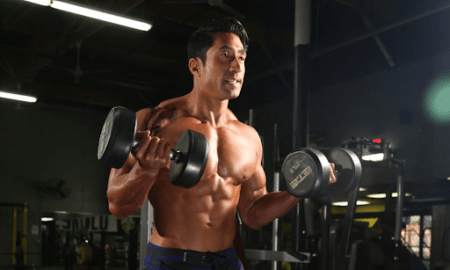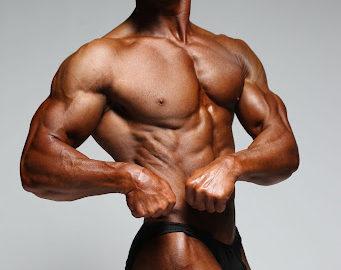A fitness model/fitness trainer/college professor training arms is a totally different animal from a top competitive bodybuilder blasting out curl after curl trying to pull the tape an extra inch.
Workout Split
Day 1: Chest
Day 2: Legs
Day 3: Off
Day 4: Shoulders
Day 5: Back
Day 6: Arms*
Day 7: Off
The general rules for off days are, never take two days off in a row, and never to train more than six days in a row.
* That’s the split when he trains arms alone. More frequently he trains them in combination, working chest and triceps on day 1 and back and biceps on day 5, taking day 6 off and beginning the cycle again on day 7.
Of course, the goal of a bodybuilder is primarily—but not totally—to gain mass, while a fitness model is more interested in proportion and building a physique that plays to the camera, not necessarily the judges. Another difference is that you might not recognize a fitness model in street clothes as a bodybuilder. The sheer size and mass isn’t there. It’s not supposed to be.
If you’re not a competitor, you can learn a lot more from someone who has 24 years of training experience, is a full-time college professor, owns his own personal-training business, is a devoted husband and the proud father of four children, including a newborn, than you can from a pro. In short, you might have more in common with Jim Romagna and his daily routine than you do with Jay Cutler.
Most people aren’t going to be competitive bodybuilders, and they don’t have the time or desire to live the regimented lifestyle—or take the substances required to be a champion. On the other hand, they can glean valuable nuggets of information from Jim’s workout.
Gym Solutions for a Busy Guy
Catching up with Jim Romagna is a task in and of itself. The guy is constantly on the go—work meetings that run over, coaching his son’s little league team, dinner with the in-laws and last-minute training sessions with clients. The challenge for Romagna is to keep all the balls in the air, as well as keeping his physique in top shape for photo shoots.
His secret? “When I get in the gym, I work hard and get out,” Jim says. “There’s very little rest between sets, and I use a lot of compound movements.” Compound is the key to his workout. He chooses movements that multitask different muscle groups and prefatigues his biceps. The result is less time spent training small muscles, which gives him more time with the family.
“I’m a big believer in Crossfit training [www.Crossfit.com]. For example, when I do snatch squats, I focus on biceps so they’re worked as well; I don’t want to waste any of my workout missing muscles on compound lifts.
“It all comes down to mental focus,” he adds. “You can work what you want to work when concentrating.”
Training biceps while doing bent-over rows? Clean and jerks? Snatches? Yup, all that and more. “That’s where the heavy weights come in,” Jim says. “When I do work biceps, I generally use lighter weights, focusing on form and pump rather than impressing everyone at the gym by curling the largest dumbbells I can find.
“Most true strength trainers don’t recommend training biceps at all,” he notes. “I disagree with that because I believe you have to isolate biceps somewhat in order to be truly strong.”
Meet the Mentor
Training ideas that out of the box don’t materialize overnight. Jim started working out with weights for football 24 years ago, during his freshman year in high school, and he’s had the bug since then. His first coach—the man who taught him those techniques—was Chuck Bova, now a high school strength coach in Wisconsin. The concepts he taught Jim are still considered cutting edge by most strength coaches, and Jim is in contact with him even today.
“We still talk one to three times per week over the phone,” Jim says. “It’s great to have a resource like that you can bounce ideas off, someone who’s been in the business for years and still loves what he’s doing.”
Bova, he says, is an unmined treasure. “He’s still coaching in high schools,” relates Jim, “loving every minute of instructing young kids in sound fitness and strength principals.”
After high school Jim went to college and received his bachelor’s degree in English, but he just couldn’t shake the training bug. He returned to college, earning a master’s degree in health, fitness and wellness, plus getting certified as a strength and conditioning coach and as a personal trainer. Oh, yeah, and he competed. “Just to get exposure,” he says, “but I train a lot of competitors and am active in the local bodybuilding scene.”
Form Over Mass
“Training biceps is a matter of form over mass,” Jim advises. “My personal motto is, It’s not what you lift but how you lift it.” So when he works biceps, it’s typically after he works back, but he will occasionally hit the gym with the idea of blasting his arms solo. “It all depends on feel; I’m a very instinctual trainer, listening to what my body says and then going from there.”
Jim’s biggest pet peeve, however, is when people train all arms and no back. “It should be a lot of back and a little arms for growth. You can get bigger biceps and a bigger back by focusing on the larger muscle groups.” If you’re going to work arms, either alone or on back day, however, he suggests the following workouts to get the most growth possible:
1) Supinated movements. “Always try to do something that supinates the wrist,” Jim says. He recommends straight bar curls and dumbbell curls. Vary your rep range as well as your grip position. Use 15 reps for solo biceps days and nine reps when pairing biceps with a larger muscle group. Don’t fall in love with these, however: “The biggest mistake I see novice and intermediate lifters make is falling too much in love with one movement,” he says. “Don’t just move your body; stimulate the muscle.”
2) Hammer curls. These are performed with your palms facing in and the thumbs up throughout the rep. That shifts the focus to the inner portion of the biceps, which encourages even growth.
“I like using a rope, but when I’m on the road, I use dumbbells a lot,” he says. He also warns against throwing the weight around. “Using the cheating principle means cheating on reps nine and 10, not on reps two through 10.” A second tip is to switch up the rhythm. As always, the focus is to keep attacking the muscle with different stresses.
3) Isolated movements. These are pretty basic biceps exercises—concentration curls, hanging curls—moves that every gym rat has grown to love (or hate, depending on the burn). Jim’s favorite concentration exercise is one he calls the “hanging concentration curl.” Lie facedown on an incline bench with your chin just hanging over the edge. Let your arms hang down, and then curl the dumbbells or barbell (with a spotter, please) to just under your chin. “I like this because it gets my body totally out of it,” he says.
The key once again is variety. “You have to keep changing things up and moving things around. The body is very adaptive and reacts best to a variety of stresses.” Jim also recommends that trainees apply his advice to every part of their workout, from resistance training to cardio.
“When I do my cardio, I run, bike, teach spinning classes, anything to keep things new,” he says. Don’t ever be afraid to try something new, even training back to grow your biceps. Don’t skip on the intensity either. “My longest workout is 50 minutes,” Jim states. “I strongly believe in short rest periods and rather quick rep speeds to increase the cardio effect of resistance training.”
Speaking with Jim Romagna is like taking a master class in fitness training—just what you’d expect from someone who’s been in the industry for 24 years and has a master’s degree. After a short time, however, you start to realize that his training principles, while advanced, are ideas you can take into the gym whenever you train. Isn’t that what the bodybuilding lifestyle is all about?
Editor’s note: To contact Jim Romagna regarding sponsorships, guest appearances or personal-training consultation, write to fit@JimRomagna.com. IM




















You must be logged in to post a comment Login